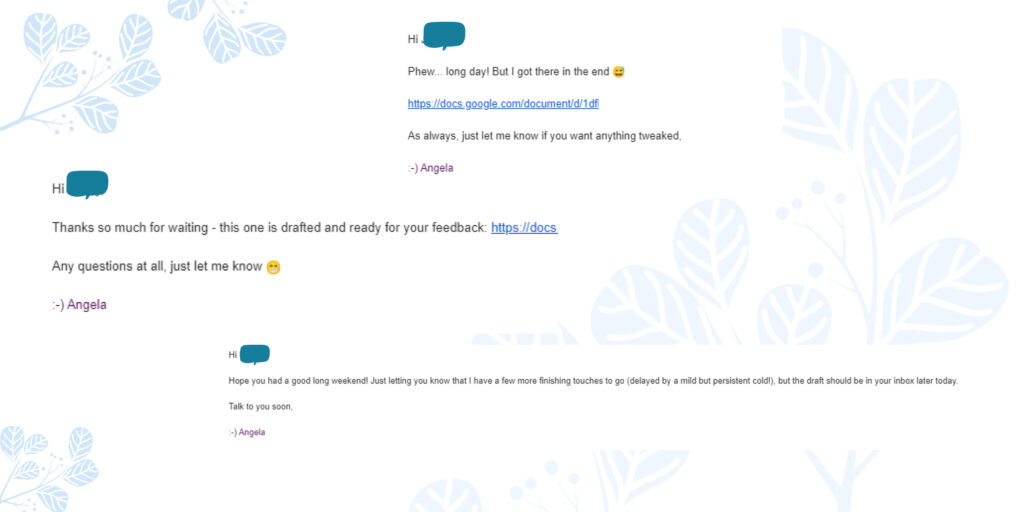In an age of AI writers, it can be hard to know what’s real and what’s not. Am I just a bot? Or am I a human writer? Is there a real person behind the screen writing every word… or perhaps just another AI prompter spitting out content scraped from the WWW (Wherever, Whatever, Who-Cares-Anyway)?
Well ladies and gentlemen, today I bring you definitive proof that your writer is, in fact, Very Human. Here you go…
Proof #1: Sometimes I’m Late

Occasionally despite my best efforts (and to my own great disappointment) I am late with a deadline. This is because unlike an AI writer, I cannot generate my content in a matter of seconds. Most of it takes days and sometimes weeks to pull together because I care about getting it as good as it possibly can be.
And unlike an AI writer, I also sometimes catch germs that take me offline, I have small children to look after (that also catch said germs), and my fluctuating energy levels dictate my capabilities.
If you’re ever looking for solid proof your writer is real (and using legit methods to produce their content) this is it.
Proof #2: You Can See My Face on Camera

Despite my reluctance to communicate in any form other than writing, I do regularly meet with clients over Zoom (above, you can see a screen grab of me awkwardly waiting for a client to join a recorded call). I used to make it a standard practice to meet everyone on a video call before the first project to make sure we get along well (and talk about said project) but now I have a secondary purpose: proof of humanity.
Now, I know that AI has some pretty impressive video capabilities and perhaps it could set up a video meeting with you. But if you look closely, you’ll notice plenty of clues that you are dealing with The Real Me, such as:
- Flyaway hairs and more freckles than you can count (AI would almost certainly have perfect skin and hair)
- An almost total lack of eye contact with the camera (if it was AI, I’m sure they’d look at the camera nearly the whole time with a scheduled blink precisely every 7 seconds)
- A jumble of Very Human background noises such as birds squawking, a washing machine on spin cycle, loud vehicles zooming past, and my frantic tapping away at the keyboard
Proof #3: Long-Term Consistency

AI writing is a relatively new phenomenon. Almost nobody was talking about it before 2023. Fortunately, I’ve been around for a lot longer than that.
If you really feel the need, you can scroll back on my blogs to around 2017, and my Instagram to 2015. And you’ll see that I am the same freckle-faced, flyaway-hair person I always have been — albeit a little pregnant in some of my photos. But more importantly, you can look at the written content to see how my style and tone of voice has remained consistent in some ways (emojis and smiley faces always feature heavily), but also evolved (particularly in the topics I cover and my use of personal storytelling over just sharing the facts).
Until AI can figure out how to time travel, an AI writer (or a writer that is copy-pasting from AI tools) won’t be able to show a detailed, time-stamped history of consistent work.
This post is mostly in the name of fun, of course. I’m not sure that anyone actually suspects I am a bot (though perhaps this will be a genuine concern in the future!). But before I wrap up, let’s get serious for a second…
I sense that much of the hype of early 2023 has died down and that most businesses and marketers are now fairly aware of the downsides of using AI-generated writing.
But just in case…
Why Care if Your Writer is Human or Not?
In case you’re on the fence about whether to fire up an AI writer or hire a human copywriter, here’s a few compelling reasons to go for the human:
- AI is recognisable – Savvy audiences can now spot AI writing easily and don’t appreciate being served AI content — why bother reading something that you couldn’t be bothered to write?
- The bots can’t compete – Content writing and copywriting for the web has been extremely competitive for a long time now, and the brands that get visibility, clicks, and conversions are those with the top-tier stuff (that you can’t get from AI).
- Shortcuts are risky – AI-generated content might open you up to some awkward legal/ethical issues — you may unknowingly be scraping another author’s content or even spreading misinformation.
- It isn’t good enough – Search engines and social media algorithms reward brands that produce great content, but AI writing tools lack the creativity and context understanding that is needed to produce useful pieces that people want to read.
If you’re still not sure, go ahead and try the AI writer. It’s cheap, you might have some fun with it, and it won’t take you long to see the limitations.
That’s not to say that AI writing tools are bad. Actually, I’d happily use them as part of my process (I have dabbled and will continue to dabble) if they made my writing better and more efficient. But they’re still pretty limited in that respect. I look forward to seeing how they evolve and maybe even shaving a teensy bit of time off my projects someday. No doubt I’ll share more about it when that day comes!
I’ve detailed my thoughts on AI writing in my previous blogs, including The Basics of ChatGPT, How ChatGPT Will Impact Copywriting & SEO, and 11 Observations About ChatGPT as a Copywriter.
That’s it for now. I’m off to do some Very Human things like spend way too long researching an article I’m working on and maybe even tackle a mountain of washing.
🙂 Angela


